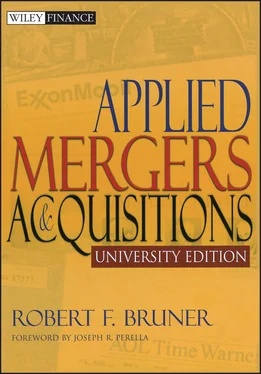Recognizing that share-for-share deals were the equivalent of an equity issue by the buyer, Shleifer and Vishny (2001) modeled the behavior of buyer managers during “hot” and “cold” equity markets and found that merger activity (especially waves), form of payment, and who buys whom are driven by the relative valuations of the pairs of firms, synergies, and the time horizons of the managers. For instance, stock acquisitions are used by buyer managers who perceive that their shares are overvalued in the market—during buoyant stock markets, this would explain why we observe relatively more share-for-share deals; and it would explain the preponderance of cash deals in cold markets. They write, “Stock acquisitions are used specifically by overvalued bidders who expect to see negative long run returns on their shares, but are attempting to make these returns less negative than they would be otherwise. The examples of the acquisition of Time-Warner by AOL and of build-up of high valuation conglomerates with stock illustrate this phenomenon.” (Page 19) This would also explain the periodic appearance of momentum-style acquisition strategies (see Chapter 17for more on momentum acquiring). Shleifer and Vishny conclude:
We do not assume that markets are efficient, but rather that the stock market may misvalue potential acquirers, potential targets, and their combinations. In contrast, managers of firms are completely rational, understand stock market inefficiencies, and take advantage of them in part through merger decisions. This theory is in a way the opposite of Roll’s (1986) hubris hypothesis of corporate takeovers, in which financial markets are rational, but corporate managers are not. In our theory, managers rationally respond to less than rational markets. (Page 2)
Rhodes-Kropf and Viswanathan (2003) (RV) build on this framework. While Shleifer and Vishny offer a rationale for the behavior of buyers, why should targets accept stock offers from buyers whose shares are likely to be overvalued? RV suggest that targets are canny enough to assess the misvaluation of the buyer and target, but not canny enough to correctly assess the value of synergies—this is because of an information asymmetry between the buyer and target in which the buyer has a better idea of the possible economic gains between the two firms. They write, “Thus, when the market is overvalued then the target is more likely to overestimate the synergies even though he can see that his own price is affected by the same overvaluation .” (Page 2) Ang and Cheng (2003) give empirical evidence in support of the overvaluation/information asymmetry theory. Based on a sample of 9,000 observations from 1984 to 2001, they find:
Acquirers are much more overvalued than their targets. Successful acquirers are more overvalued than the unsuccessful ones. The probability of a firm becoming an acquiree significantly increases with its degree of overvaluation, after we control for other factors that may potentially affect the firm’s acquiring decision. Since overvalued acquirers could only gain from their misvaluation by paying for the acquisitions with their stocks, we postulate and verify that stock-paying acquirers are substantially more overvalued than their cash-paying counterparts…. The probability of stocks being utilized as the payment method significantly increases with the acquirer’s overvaluation. Long-term abnormal returns of the combined firms in stock mergers are negative. (Pages 3–4)
The new theory of overvaluation and information asymmetry does little to explain the clustering of M&A activity in industries, but it advances our understanding of merger waves and lends a couple of practical implications. First, it helps explain the association between the buoyant stock markets of the 1960s, 1980s, and 1990s and the coincident large merger waves. Second, it presents a framework for thinking about the form of payment (about which more is said in Chapter 20). As a practical matter, then, this theory invites executives to consider three questions:
1 What is the level of the market today? Deal makers will be influenced by the relative levels of valuation. The practitioner can compare valuation multiples such as the price/earnings ratio or market/book ratio for the market averages today, with those prevailing in the past. During 1998–2000, such a comparison showed the market to be highly valued (“irrationally exuberant” in Robert Shiller’s terms).
2 What is the valuation of my firm relative to the market? If you want to figure out where your firm is likely to be in the food chain, focus on its valuation relative to other firms. The new theory suggests that more overvalued firms will be buyers, and less overvalued firms will be targets.
3 What do I know that the market doesn’t? This is one of the fundamental questions M&A practitioners should always ask. The new theory lends weight to it by suggesting that most practitioners ask it. The timing and form of payment of M&A activity is basically motivated by a disparity between one’s own assessment of the intrinsic value of the firm and the market price. The theory suggests that the main basis for believing that your estimate of intrinsic value is better than the market price is because of an information advantage.
Agency Costs and the Correction of Governance Problems
The wave of M&A activity in the 1980s differed from others in two important ways: the relatively high volumes of hostile takeovers and of leveraged buyouts. Arguments prominently associated with Michael Jensen suggest that this was a decade of the disciplinary response of investors to the mounting agency costs of entrenched managements. Agency costs are inefficiencies arising from such things as self-interested risk management, 7 perquisites, and lax attention. These costs accumulate because of the failure of directors to monitor and control the management of the firm in the best interests of its shareholders. Shareholders bear the costs of agency problems in the form of depressed share prices. Taking over the firm and restoring it to more efficient operation rewards new management with profits in the form of dividends and capital gains.
A great deal of empirical evidence is consistent with this view. Chapter 6summarizes findings that restructuring and redeployment of assets is profitable to investors. Chapter 20surveys studies that report gains from leveraged buyouts and highly levered transactions. Holmstrom and Kaplan (2001) summarize findings that the 1980s were a wave of corrective M&A.
But did these corrective forces appear only in the 1980s and not in the other waves? The profit-seeking behavior should always be present. And what about the clustering of M&A activity within industries, or mergers between firms that are well governed? Still, the agency theory raises useful questions for the practitioner:
How efficient are my firm and the potential buyers and targets in its arena? Efficiency is a fundamental gauge to explaining who will be buyers and targets. The more efficient take over the less efficient firms.
To what extent do governance problems contribute to differences in efficiency? The quality of governance of a firm should be a telltale for the firm’s efficiency. Chapter 26summarizes research findings that good governance pays and summarizes dimensions on which one could assess the quality of governance.
Monopoly, Competitive Positioning, and “Rent-Seeking” Behavior
The long literature in Industrial Organization within economics studies the relation between returns on one hand, and firm size or market power on the other. Chapter 6summarizes some of these relations and the uses of M&A to enhance the position and market power of the firm. The literature suggests that the creation of monopolies and collusive oligopolies permits producers to extract excessive returns from consumers—this is the so-called “rent-seeking” behavior condemned by public policy analysts. Active antitrust enforcement by governments is a brake on the creation of monopolies through M&A. The M&A waves of the 1890s and 1960s were seriously curtailed by antitrust enforcement action. Chapter 28surveys the antitrust laws in the United States and their implications for deal development. Still, within the confines of antitrust law, firms have some latitude to exploit product market inefficiencies. A stream of literature, stimulated by Michael Porter (1980) sketches techniques by which firms may enhance their competitive position—this is surveyed in Chapter 6.
Читать дальше












